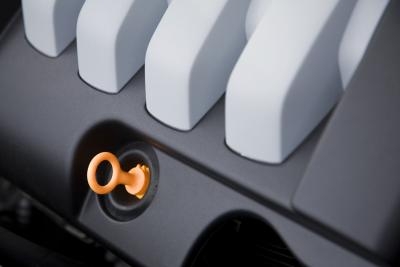
Although exhaust noise is the single loudest part of engine noise, it is far from the only part. Fuel injectors clatter. Valves tap when they close and make a metallic screech when they open. Alternator bearings whine. Air whooshes through the air filter and intake tract. Cooling fans make a rushing sound, and your serpentine belt makes a sound not unlike a faraway train. Soundproofing an engine means insulating the engine in a way that obstructs the passage of sound. It requires a systematic approach and some familiarity with automotive engines.
Install an aftermarket dual exhaust system about 1/2-inch larger than your stock system. Use tubing with the thickest walls available, usually about 3/16-inch. Install the system at two high-capacity resonators per tube, ahead of the rear axle.
Install a pair of very quiet mufflers designed for a new compact car. You might want to take a look at resonators designed for a BMW 3-series and a pair of mufflers designed for a Toyota Prius or Honda Civic ES.
The high flowing exhaust system will reduce air density and sound transfer in the system, and the thick pipes will reduce exhaust drone. The resonators will reduce high-frequency sound waves, allowing the mufflers to function more efficiently. The low frequency sound waves that do make it out will be far less obvious and more pleasant to the ear.
Install an intake silencer. Intake silencers are like mufflers for your air intake, but they're made of plastic instead of metal. Air can make a very pronounced whooshing or whining sound as it flows through the intake tube and manifold, and other engine noises can make their way out.
While the intake sound level can be fairly high, you probably won't notice how loud it is until you install a silencer. Take a look at silencers designed for Ford Mustangs and F-150s, but expect a slight drop in power if you have a large displacement engine. For larger engines, purchase a universal silencer designed for Rotax-engine-equipped small aircraft.
Install a sound insulated engine cover that covers both the fuel injectors and valve covers. This might require some fabrication if no one offers an engine cover for your application, but building one out of fiberglass isn't too difficult if you've already worked with the material.
Build a lower cover to fit over the engine, then glue sound dampening mat on top of it. Cover that with another layer of fiberglass, sand it smooth, then prime and paint it with the color of your choice. You will have a sound deadener that enhances your engine's appearance by covering up all those ugly wires and sensors.
Install a sound absorbing mat on the underside of your hood. If no one sells an aftermarket sound deadening mat, you can make your own by purchasing a universal mat and cutting it to fit. Glue the mat into place for a noticeable drop in decibels.